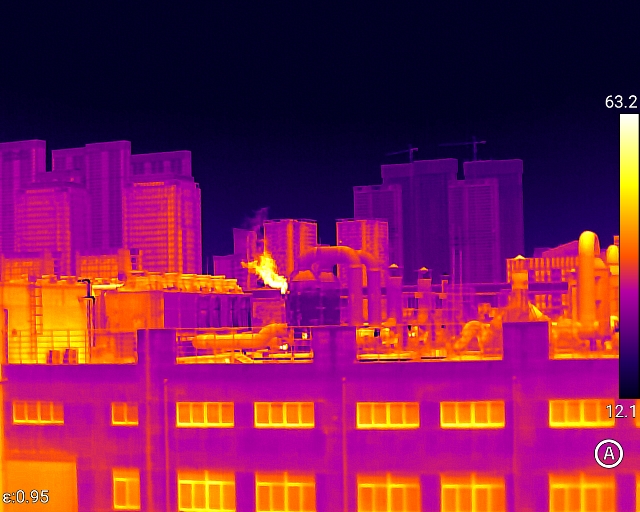A Smartphone Thermal Camera: A Futuristic Approach to Thermal Imaging
What is a Thermal Camera?
Thermal cameras don't operate the same as regular cameras. The human eye and conventional daylight cameras both operate on the same fundamental tenet: visible light energy strikes something, bounces off of it, a detector collects the reflected light, and then transforms it into a picture, whereas thermal cameras were developed to catch objects in the dark. It takes a photograph of the object that accurately depicts its temperature using infrared radiation that the object emits. Infrared light is transformed into electric impulses in thermal imaging, which is then used to build an image.
How Do Thermal Cameras Operate?
A heat signature, or thermal energy, is emitted by every object. The question is how thermal imagers use that energy to create the images. The components of a thermal camera include a lens, a heat sensor, processing circuitry, and a mechanical casing. Infrared light is focused on the sensor by the lens. The sensor can have any number of grid-arranged pixel combinations, ranging from 80*60 to 1280*1024 pixels or more.
The infrared energy emitted on each sensor pixel causes it to react, generating an electrical signal. The camera processor uses each pixel's signal to do a mathematical computation and build a color map of the object's perceived temperature. A separate color is allocated to each temperature value. The resulting color matrix is transmitted to memory and displayed on the camera's screen as a thermal image, which is also a representation of the object's temperature.
Thermal Imaging Camera Applications
As advantageous and intelligent as thermal cameras may sound, they have various uses outside of the household and in a variety of professions. Below are several advantageous applications for a thermal camera.
Security and Law-Enforcement
The initial development of the thermal imaging camera was for military use during the Korean War, but currently, the usage of integrated cameras with thermal imaging technology is widespread among military organizations. The use of thermal imagers in home security has also increased recently due to their ability to find hotspots even on the darkest nights. Thermal imaging technology is also used by law enforcement to oversee surveillance operations, track down criminals, examine crime scenes, and carry out search and rescue missions.
Application in Power Line Maintenance
Thermal cameras are widely used by power-line maintenance technicians in order to pinpoint joints, parts, and components that are at risk of overheating and remove them to prevent any potential problems
Use in Medical Field
Medical thermal cameras are incredibly accurate tools capable of determining the temperature of the skin's surface and accurately and informatively capturing images of every part of the human body. It also makes it easier for thermographers, operators, or medical professionals to determine whether a temperature is normal or excessive. Portable thermal imaging cameras are also utilized in public settings to help identify a person with a fever in the crowd and isolate them.
Use in Wildlife
The use of infrared cameras by hunters and animal conservationists has become commonplace. Infrared wildlife cameras are utilized for more than just hunting; they can provide in-depth observations and insights into animal behavior. They also make it easier to perform wildlife surveys in an entirely non-intrusive manner. An infrared wildlife camera offers more insights into the nearby wildlands because some animal groups are more active at night.
Use in Scientific Research
The use of thermal imaging technology unquestionably has a big positive impact on the research and development industry. Today's technological advancements owe a lot to the understanding of and direct or indirect use of infrared and thermal cameras in science. It is used in science to visualize heat patterns more precisely and accurately.
Transport Services
Thermal imaging has a significant positive impact on transport navigation, especially at night or in low-visibility situations like fog, rain, or snow. It serves as a passive security measure to alert drivers to any potential risks on the road. Infrared cameras have started to be incorporated into cars recently to warn drivers of individuals or animals that are outside the range of their headlights or streetlights.
Features of a Thermal Imaging Camera
You can buy thermal imaging cameras with the bare minimum of features, which only read the temperature of the fixed object on display, or with a variety of features, which let the user select a number of moveable crosshairs and compare them to each other to display the high, low, and average temperatures. There are some crucial features and specifications you should take into account regardless of whether you select a basic point-and-shoot model or a high-end thermal camera.
Knowing what you want in a smartphone infrared camera is important. Always look for higher-resolution cameras with a range of operating temperatures. Watch out for color schemes as well. When using a monochromatic palette, such as grayscale or amber, it is simpler to spot little changes. High-contrast colors might make it simpler to spot obvious irregularities quickly. The program or the camera ought to allow you to adjust the palette. Last but not least, make sure to choose a camera with long battery life.
Given what you now know about thermal cameras and their capabilities, wouldn't it be easier if everything fit inside your smartphone? Guide Sensmart now offers the best smartphone thermal camera. You can either get your hands on a MobIR 2T, which has a focus of 3.2mm and also includes a function of autofocus that not only makes your task a lot easier and faster but also your images clearer, or you can get a MobIR 2S, which can be your all-around partner in your every day, work, or adventurous life. They both have incredible 256*192 IR resolution. On our website, you can read more about the specs and features of their smartphone thermal cameras. Therefore, stop waiting and visit their website right away to choose the best and most convenient smartphone thermal camera for you.













.svg)


(1).jpg)
(1).jpg)

